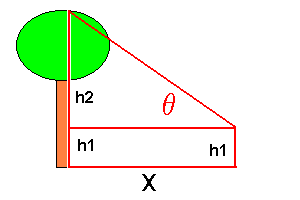
For measurements, you may give a range, e.g. 3 to 5 mm. Use metric measurements. For shapes, you may use a "to" statement, e.g. blades ovate to lanceolate. Refer to your vegetative and floral character and morphology handouts to help with the terminology.
Many of these sections apply only to angiosperms, some sections would be omitted for gymnosperms and seedless vascular plants. Use your best judgement and adapt the descriptions seen below.
The items in blue need only be done for the three plants that are being turned in for the term project.
Adapted from: http://www.csdl.tamu.edu/FLORA/tfplab/pdesc.htm
First, as a group, we will practice measuring the height of a tree using trigonometry. Lee Ling will diagram this operation on the board. Two people will sight the top of a tree from two different locations with modified protractors to determine the angle theta to the top of the tree. Four other people in teams of two will measure the horizontal distance to the tree with tape measures. The height of the protractor from the ground, h1, will also be measured. The height of the tree H is then calculated from H = h1 + x tan q.

| x | q | h1 | H |
|---|---|---|---|
_______ |
_______ |
_______ |
_______ |
After learning this skill, necessary for students who are choose trees for their term project, students will work in laboratory groups of two.
As a twosome, pick a plant that is in flower and write up a full description as shown above. You will need to walk around the campus to find a flower that you and your partner wish to work on. Remember that there are flowers all around the campus - don't be afraid to walk around to find the particular flower you want to use. Last week we looked at a number of different flowers on and around campus.
Do not pick any of the potted or planted flowers around campus. Do not picked any obviously owned flowers. You may need to use magnifying glasses to inspect the flower.
Remember that Asteraceae (sunflowers with head type inflorescence) have both a disk flower in the center and a ray flower around the edge. Many of the Asteraceae disk flowers would be best imaged by using the magnification capabilities of the scanner. It is acceptable for two groups to do the same flower.
If it is not raining, then Lee Ling should have the digital camera so that pictures can be taken of your plant and flower.
If the flower is not potted or planted and does not obviously belong to anyone you can pick the plant and flower and scan the flower and leaves in with the scanner.
Use Microsoft FrontPage in the A204 laboratory to write up your plant description. Lee Ling will demonstrate FrontPage near the beginning of the laboratory. Lee Ling will have to work with groups on the digital camera images in his office during the coming days - the digital camera software is all connected to the computer in F105.
Due to be turned in two weeks times: A single page description conforming to the above 22 sections with images of the leaves, plant habit, inflorescence, and flower.